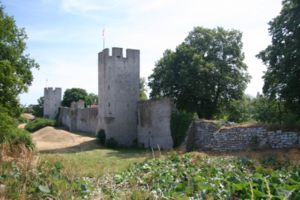
Battle of Visby
Encyclopedia
The Battle of Visby was fought in 1361 near the town of Visby
on the island of Gotland
, between the forces of the Danish king and the Gutnish country yeomen. The Danish force was victorious.
(Valdemar Atterdag) sent an army ashore on Gotland's west coast. The Gutes of Gotland paid taxes to the King of Sweden, though the population of Visby was diverse and included Russians, Danes and Germans. In 1280, the city of Visby had joined the Wendish City-alliance along with Riga
, Lübeck
, Tallinn
and other large population centres from northern Europe, further separating Visby from the Gutnish contryside. Antagonism between city-dwellers and the Gutnish country yeowmen heightened, and the latter were defeated in battle in 1288 despite the aid of knights from Estonia.
 The Danish troops moved towards Visby. The first day of the invasion, two minor skirmishes were fought on marshy ground between yeowmen farmers and the army. The next day, from 800 to 1000 farmers were killed after massing for battle near Fjäle myr.
The Danish troops moved towards Visby. The first day of the invasion, two minor skirmishes were fought on marshy ground between yeowmen farmers and the army. The next day, from 800 to 1000 farmers were killed after massing for battle near Fjäle myr.
On 27 July a Gutnish yeowmen army fought the Danes just outside the city, and were severely beaten, with an estimated death toll of about 1,800 peasants killed while the Danish casualties remain unknown. Only a couple of items that can be linked with Danish soldiers have been found, including a purse, and an ornamented armour belonging to a member of the Roorda Family from Friesland.
Casualties can be compared with those that the French suffered at the Battle of Poitiers
in 1356 and should be seen as high in medieval standards.
.jpg) Following the devastating battle, the citizens of Visby decided to surrender to avoid further losses. To save the city from sacking the inhabitants paid large amount of their wealth to King Valdemar. This extortion of contributions became a legendary event, although it can not be confirmed to have taken place, and if so, the events are unclear. Despite the payment, the Danes plundered several churches and monasteries.
Following the devastating battle, the citizens of Visby decided to surrender to avoid further losses. To save the city from sacking the inhabitants paid large amount of their wealth to King Valdemar. This extortion of contributions became a legendary event, although it can not be confirmed to have taken place, and if so, the events are unclear. Despite the payment, the Danes plundered several churches and monasteries.
King Valdemar appointed sheriff
s to govern Visby and then set sail again. It would take another year before Valdemar officially added "King Of Gotland" to his many titles. When Albert, King of Sweden took the Swedish crown he claimed Gotland as part of his domains and held the island at least until 1369; thus the Danish presence there couldn't have been strong, as it so rapidly and easily returned to the Swedish crown. The island would be disputed over by the House of Mecklenburg and the Danish Crown until 1376 when Queen Margareta
(the daughter of the late King Valdemar) officially claimed the island for Denmark.
King Albert was defeated in a civil war in 1389, in which Queen Margareta supported the "rebels", and was forced to abdicate. However, he was granted Gotland and its "capital" Visby, where he remained with a "pirate" organisation called the Victual Brothers
. It was not until 1408 that the last remains of the house of Mecklenburg and the above mentioned pirates were driven out for good.
Five mass-graves were located outside the city's walls.
Visby
-See also:* Battle of Visby* Gotland University College* List of governors of Gotland County-External links:* - Visby*...
on the island of Gotland
Gotland
Gotland is a county, province, municipality and diocese of Sweden; it is Sweden's largest island and the largest island in the Baltic Sea. At 3,140 square kilometers in area, the region makes up less than one percent of Sweden's total land area...
, between the forces of the Danish king and the Gutnish country yeomen. The Danish force was victorious.
Background
On 22 July 1361, King Valdemar IV of DenmarkValdemar IV of Denmark
Valdemar IV of Denmark or Waldemar ; , was King of Denmark from 1340 to 1375.-Ascension to the throne:...
(Valdemar Atterdag) sent an army ashore on Gotland's west coast. The Gutes of Gotland paid taxes to the King of Sweden, though the population of Visby was diverse and included Russians, Danes and Germans. In 1280, the city of Visby had joined the Wendish City-alliance along with Riga
Riga
Riga is the capital and largest city of Latvia. With 702,891 inhabitants Riga is the largest city of the Baltic states, one of the largest cities in Northern Europe and home to more than one third of Latvia's population. The city is an important seaport and a major industrial, commercial,...
, Lübeck
Lübeck
The Hanseatic City of Lübeck is the second-largest city in Schleswig-Holstein, in northern Germany, and one of the major ports of Germany. It was for several centuries the "capital" of the Hanseatic League and, because of its Brick Gothic architectural heritage, is listed by UNESCO as a World...
, Tallinn
Tallinn
Tallinn is the capital and largest city of Estonia. It occupies an area of with a population of 414,940. It is situated on the northern coast of the country, on the banks of the Gulf of Finland, south of Helsinki, east of Stockholm and west of Saint Petersburg. Tallinn's Old Town is in the list...
and other large population centres from northern Europe, further separating Visby from the Gutnish contryside. Antagonism between city-dwellers and the Gutnish country yeowmen heightened, and the latter were defeated in battle in 1288 despite the aid of knights from Estonia.
Battle

On 27 July a Gutnish yeowmen army fought the Danes just outside the city, and were severely beaten, with an estimated death toll of about 1,800 peasants killed while the Danish casualties remain unknown. Only a couple of items that can be linked with Danish soldiers have been found, including a purse, and an ornamented armour belonging to a member of the Roorda Family from Friesland.
Casualties can be compared with those that the French suffered at the Battle of Poitiers
Battle of Poitiers (1356)
The Battle of Poitiers was fought between the Kingdoms of England and France on 19 September 1356 near Poitiers, resulting in the second of the three great English victories of the Hundred Years' War: Crécy, Poitiers, and Agincourt....
in 1356 and should be seen as high in medieval standards.
Aftermath
.jpg)
King Valdemar appointed sheriff
Sheriff
A sheriff is in principle a legal official with responsibility for a county. In practice, the specific combination of legal, political, and ceremonial duties of a sheriff varies greatly from country to country....
s to govern Visby and then set sail again. It would take another year before Valdemar officially added "King Of Gotland" to his many titles. When Albert, King of Sweden took the Swedish crown he claimed Gotland as part of his domains and held the island at least until 1369; thus the Danish presence there couldn't have been strong, as it so rapidly and easily returned to the Swedish crown. The island would be disputed over by the House of Mecklenburg and the Danish Crown until 1376 when Queen Margareta
Margaret I of Denmark
Margaret I was Queen of Denmark, Norway and Sweden and founder of the Kalmar Union, which united the Scandinavian countries for over a century. Although she acted as queen regnant, the laws of contemporary Danish succession denied her formal queenship. Her title in Denmark was derived from her...
(the daughter of the late King Valdemar) officially claimed the island for Denmark.
King Albert was defeated in a civil war in 1389, in which Queen Margareta supported the "rebels", and was forced to abdicate. However, he was granted Gotland and its "capital" Visby, where he remained with a "pirate" organisation called the Victual Brothers
Victual Brothers
The Victual Brothers were a companionship of privateers who later turned to piracy. They were hired in 1392 by the Dukes of Mecklenburg to fight against Denmark, because the Danish Queen Margaret I had imprisoned Albrecht of Mecklenburg and his son in order to subdue the kingdom of Sweden...
. It was not until 1408 that the last remains of the house of Mecklenburg and the above mentioned pirates were driven out for good.
Archaeological excavation
Graves have been excavated in modern times to bring clarification in the events. It showed that at least a third of the Gotlandian army consisted of minors and elderly. Many of the dead defenders were unusually buried in their armour; because supposedly, according to historian John Keegan "...hot weather and their great number (about 2,000 bodies were disinterred six hundred years later) defeated the efforts of the victors to strip them before decomposition began." The site of the excavation "yielded one of the most fearsome revelations of a medieval battle known to archaeologists."Five mass-graves were located outside the city's walls.
Further reading
- Thordeman, Bengt Invasion på Gotland 1361, 1944
- Thordeman, Bengt Armour from the Battle of Visby I-II (in collaboration with Paul Nörlund and Bo E. Ingelmark), 1939–40
- Westholm, Gun Visby 1361, Invasionen

